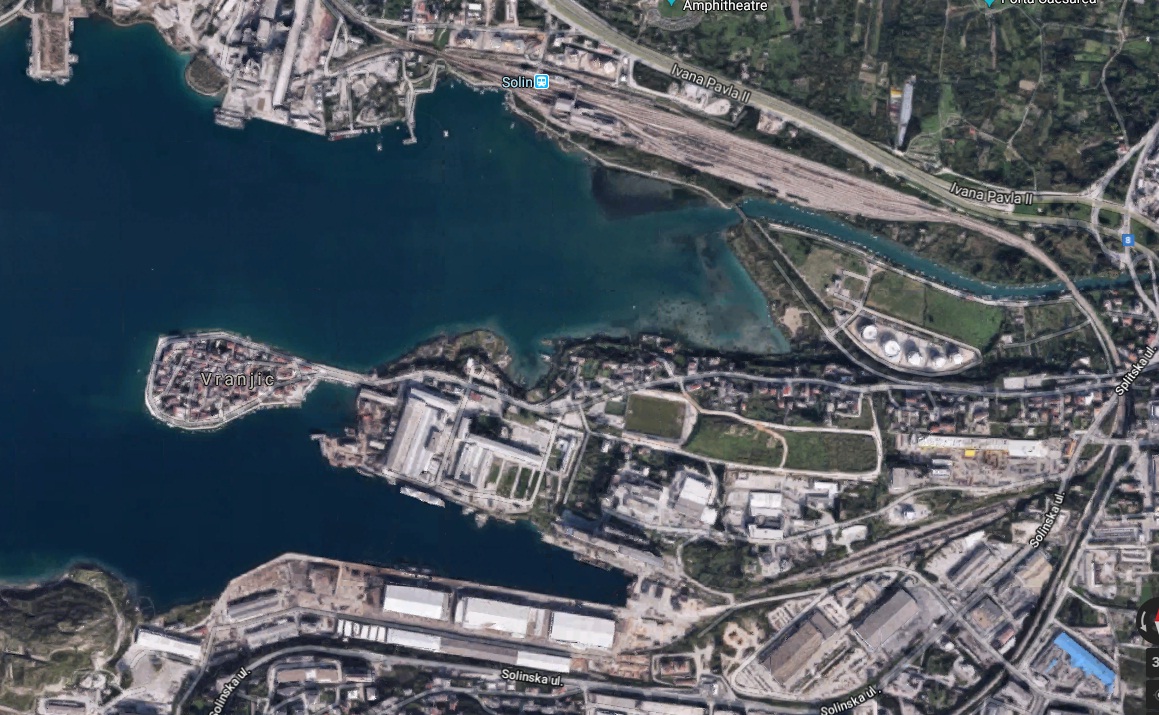Grad Solin Zanimljivosti ZP Izdvojeno
Four reasons why you should never visit Vranjic
Vranjic is a beautiful small town, situated on peninsula it was nicknamed “ Little Venice “ Vranjic is placed on north side of Split, near the mouth of Jadro River and it is part of the municipality of Solin. The ambiance of present-day Vranjic is heavily degraded by the surrounding industries.

View to Cemex factory from riva in Vranjic – Dron view to INA reservoirs (industry of oil) – Dron view to ex Salonit company and North port of Split
So, the name of this article is why this place isn’t good for your vacation.
When you come to this place at first you see picturesque marine ambient but that ambient isn’t normal when you see on north chimies of factory, on east when you see big oil gallon or on the south industrial port of Split and in the center of the town you see remains of the former Salonit factory. Obviously you don’t have any wish to lay down on beautiful sun promenade or just swim in the sea. This beautiful town has had even evidence of life from prehistory stop his touristic developed thanks to the industry or to the monsters that are in the neighborhood. Of course factories are good for local community and infrastructure but not for a long time and as the example on this city have really bad consequences today and for the future.
Who are these “monsters “who has stolen one city and how he lost his beautiful nickname.
Let’s write something about them. Today there are lot’s of ecological organization who work on changes something for these problems But they work hard and they make something but still we have evidence in environment and infrastructure that stole future of this small town.
First of them is Salonit company was a state owned factory located in Vranjic.
Most of this story I’ll dedicate to this company. This factory is the worst monster specially for the citizen of Vranjic. The company had been producing construction materials that contained asbestos since the 1920s. By the end of the 1990s, 250 of Salonit’s workers and a few hundred of Vranjić’s citizens were officially diagnosed with asbestos disease (an incurable lung disease). In 1999, the Croatian Government accepted to compensate some sick workers to an extent, but the process was plagued with numerous irregularities. In 2006 Salonit was closed and declared bankruptcy, as Croatia adopted the EU decision from 2005 to strictly ban the production, sale and usage of asbestos. However, research into documents from the Customs Authority about the quantities of asbestos products imported into Croatia since the absolute ban of January 2006 show that 11,677 tonnes of asbestos products were imported into Croatia until 2012 (out of that 87% came from the EU). In 2008, the Croatian Government launched a clean-up and sanitation program of asbestos contaminated areas in town of Vranjic, including these three ‘hot spots’: the production building, Marvička kava – the depot for asbestos containing materials from the factory, and the northern part of Vranjic peninsula where large amount of asbestos had been disposed into the sea. Also, it is important to note that some workers had been involved in process of remediation of Salonit but, in 2009, the bankruptcy manager of Salonit company did not renew their working contracts. The workers claimed that this decision was not in line with the guaranties they received from the Prime Minister in relation to their employment on remediation of the factory, and they organized hunger strikes. The clean-up program was done, however according to local organizations provoking even greater ecological damage, as the process did not fully respect EU sanitation norms. The workers and citizens claimed irregularities to the state authorities and demanded justice and compensation.
Thanks to the laws on professional illnesses, 170 of Salonit’s workers (who had working contracts in 2006, when the company filed for bankruptcy) received compensation in 2011. However, the laws do not cover persons with diagnosed asbestos, such as ex-Salonit workers that stopped working before 2006. These people did not receive compensation, nor have they managed to obtain disability pensions.
Other monsters are industrial cement factories they start on the west cost of Split port, north industrial port of Split located in Dujmovača there from 1875, St. Kajo- Solin from 1904, Meterize- Solin, 1950, Kaštel Sućurac since 1912.
All this factories surround Vranjic. So, ruin of this beautifull small town start with this industry that starts in the end of 19. century. Industry of cement is ecological disaster not only ecological is urbanistic disaster because of exploitation from mines. All these factories aren’t heritage from Communism they are heritage from Austrian rule in Dalmatia.
In 1904 they built a new cement factory in Solin whose production was based on marl exploitation from Kozjak mountain slopes. In 1907 this factory became a chapter of the society ”Societa anonima cemento portland dell’Adriatico” with its main centre in Bergamo. Stock then sold his shares and a year later built a new factory of the Joint Stock Company for Portland Cement ”Split” in the Solin’s area Majdan near the Jadro river source. The Jadro river was used for electrical energy production and technological water. The warehouses and operational quay were built in Vranjic while the electrical rail transport was placed between the factory and the quay. The seventh cement factory in Dalmatia before World War I was the one in Kaštel Sućurac built in 1912. In 1957 all Dalmatian cement factories merged into a unique company named ”Dalmacijacement”.
Not only cement factory but there are INA (industry of oil) reservoirs that are situated on north of Vranjic in Solin and in the entrance to the city it is gas-oil station.
In north-port of Split that is south of Vranjic is the beer factory and big shipyard.
In the end Vranjic or little Venice is beautiful dalmatian city but with a really bad luck. Yes, as I already sad lot of ecological organisation work to save this place but to be honest damage is done and took lot of victims.






